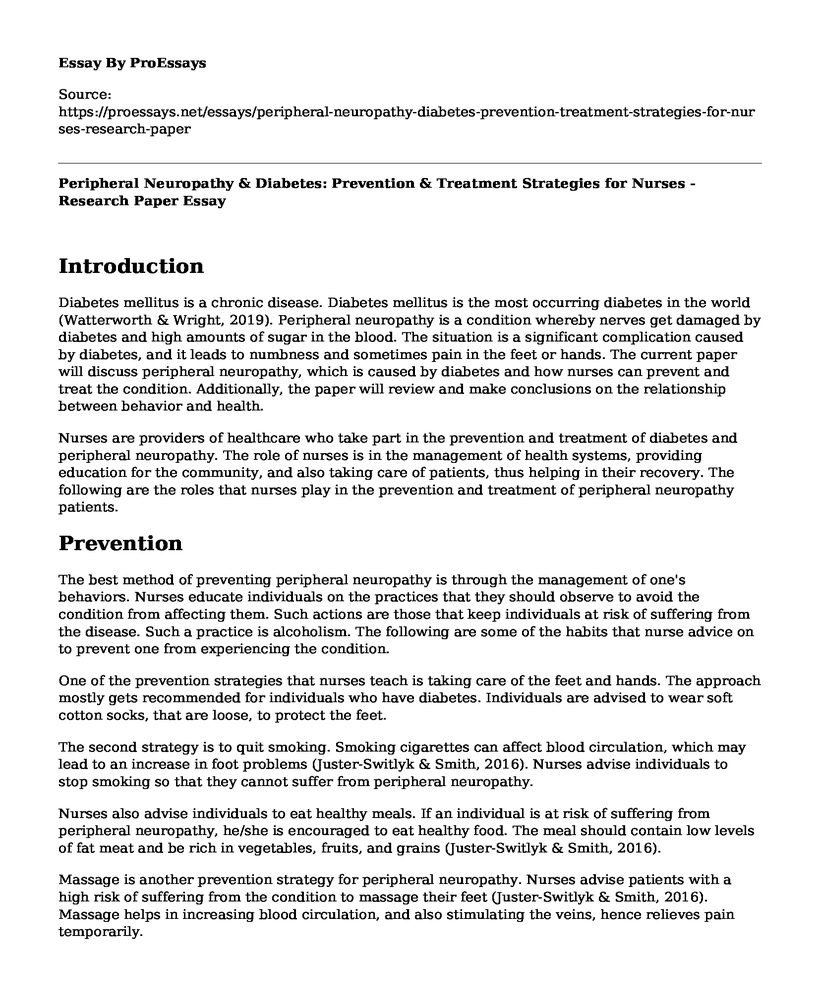Introduction
Diabetes mellitus is a chronic disease. Diabetes mellitus is the most occurring diabetes in the world (Watterworth & Wright, 2019). Peripheral neuropathy is a condition whereby nerves get damaged by diabetes and high amounts of sugar in the blood. The situation is a significant complication caused by diabetes, and it leads to numbness and sometimes pain in the feet or hands. The current paper will discuss peripheral neuropathy, which is caused by diabetes and how nurses can prevent and treat the condition. Additionally, the paper will review and make conclusions on the relationship between behavior and health.
Nurses are providers of healthcare who take part in the prevention and treatment of diabetes and peripheral neuropathy. The role of nurses is in the management of health systems, providing education for the community, and also taking care of patients, thus helping in their recovery. The following are the roles that nurses play in the prevention and treatment of peripheral neuropathy patients.
Prevention
The best method of preventing peripheral neuropathy is through the management of one's behaviors. Nurses educate individuals on the practices that they should observe to avoid the condition from affecting them. Such actions are those that keep individuals at risk of suffering from the disease. Such a practice is alcoholism. The following are some of the habits that nurse advice on to prevent one from experiencing the condition.
One of the prevention strategies that nurses teach is taking care of the feet and hands. The approach mostly gets recommended for individuals who have diabetes. Individuals are advised to wear soft cotton socks, that are loose, to protect the feet.
The second strategy is to quit smoking. Smoking cigarettes can affect blood circulation, which may lead to an increase in foot problems (Juster-Switlyk & Smith, 2016). Nurses advise individuals to stop smoking so that they cannot suffer from peripheral neuropathy.
Nurses also advise individuals to eat healthy meals. If an individual is at risk of suffering from peripheral neuropathy, he/she is encouraged to eat healthy food. The meal should contain low levels of fat meat and be rich in vegetables, fruits, and grains (Juster-Switlyk & Smith, 2016).
Massage is another prevention strategy for peripheral neuropathy. Nurses advise patients with a high risk of suffering from the condition to massage their feet (Juster-Switlyk & Smith, 2016). Massage helps in increasing blood circulation, and also stimulating the veins, hence relieves pain temporarily.
Treatment
Peripheral neuropathy has no known cure. However, treatment of the condition helps in the prevention of further complications, and relief from painful symptoms. The following are the components that nurses apply to treat peripheral neuropathy.
The first treatment component is the control of the blood's sugar levels. An increase in blood sugar leads to an increase in pain and burning (Watson & Dyck, 2015). The current form of treatment used to maintain blood glucose levels includes insulin injection and oral medication of insulin.
Care for the feet is another component used by nurses in treating peripheral neuropathy. Individuals who suffer from the condition do not feel pain in the case of a feet injury. Therefore, it is necessary to take care of the feet because injuries may lead to further infections. The American Diabetes Association has a recommendation that individuals who suffer from the condition to visit the hospital once every year for an examination of the feet (Watson & Dyck, 2015).
Controlling pain is the third component applied by nurses in the prevention of peripheral neuropathy. The pain caused by the condition is usually intense and hard to control. The pain often is worse during the night. The good thing is that only a small portion of people suffering from the condition experience pain (Watson & Dyck, 2015). In some people, the pain may end after some time without any treatment. The FDA approves medications such as gabapentin and duloxetine for the treatment of pain in patients suffering from peripheral neuropathy.
Conclusion
Behaviors affect the health of individuals. In the case of peripheral neuropathy, certain practices lead to the condition, whereas others prevent the disease from occurring. Actions that lead to poor health, and then the state include cigarette smoking and alcoholism. Behaviors such as healthy eating reduce the occurrence of health hazards and conditions such as peripheral neuropathy.
References
Juster-Switlyk, K., & Smith, A. G. (2016). Updates in diabetic peripheral neuropathy. F1000Research, 5.
Watson, J. C., & Dyck, P. J. B. (2015, July). Peripheral neuropathy: a practical approach to diagnosis and symptom management. In Mayo Clinic Proceedings (Vol. 90, No. 7, pp. 940-951). Elsevier.
Watterworth, B., & Wright, T. B. (2019). Diabetic Peripheral Neuropathy. In pain (pp. 911-913). Springer, Cham.
Cite this page
Peripheral Neuropathy & Diabetes: Prevention & Treatment Strategies for Nurses - Research Paper. (2023, Mar 04). Retrieved from https://proessays.net/essays/peripheral-neuropathy-diabetes-prevention-treatment-strategies-for-nurses-research-paper
If you are the original author of this essay and no longer wish to have it published on the ProEssays website, please click below to request its removal:
- Essay on Documentary How to Survive a Plague
- Essay Example: Situational Analysis in the Emergency Care Unit
- Evidence-Based Practice for Type 2 Diabetes Care - Research Paper
- Essay Example on the Evolution of Obstetric Nursing: 1900s to 2000s
- Essay Example on Metformin: Approved Diabetes Medication to Reduce Glucose Levels
- Essay Sample on Covid-19: Alarming Global Spread & Healthcare Industry at Risk
- Probing Dental Implants: Collecting Critical Info - Essay Sample







